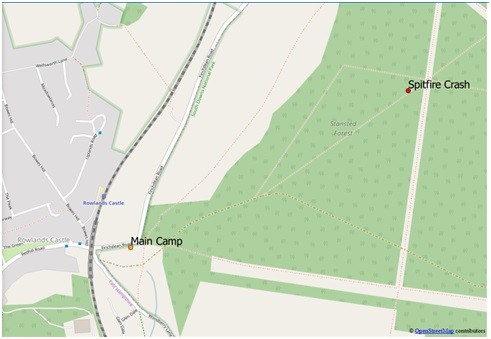Spitfire Crash 19th August 1942
In memoriam: Flight Sergeant Sigurd Gerhardt Jenssen, 129 Squadron (Mysore)
by Brian Tomkinson

Some of you will be aware that I have been researching the intriguing story of the Canadian Battle School stationed in Stansted Park in 1942. One of the interesting but poignant stories unveiled was that of Flight Sergent Sigurd Jenssen.

Sgt Jenssen, a Norwegian pilot, joined the RAFVR and flew with 129 (Mysore) Squadron which was based at Thorney Island. The events relating to Stansted centre around the Dieppe Raid of 19th August 1942. This was a dark period in the war, Nazi Germany was extremely strong, occupying most of Europe. Singapore had fallen in January and we were faring badly in North Africa having lost Tobruk in June. The Germans were well entrenched along the continental coast and in Europe our activities were restricted to Commando raids.
On the 18th August, 129 Squadron were on a sortie in the Cherbourg area when Sgt Jenssen’s aircraft was hit and most of the port aileron was shot away making the aircraft very difficult to fly and very vulnerable. He successfully made it back to base at RAF Thorney even though the returning squadron was pursued to within 30 miles of the coast by a number of FW-190’s. To quote the Operations Record Book Sgt Jenssen “made a brilliant landing in spite of this.”
On the 19th August the air activity was in support of the Dieppe Raid (Operation Jubilee). The object of the operation was to carry out a “raid in force” to see whether a channel port could be taken and held for a short period of time ie 48 hours. It was carried out by a predominantly Canadian force comprising some 5000 Canadians, 1000 British and 50 US Rangers. It was very costly for the Canadians 3367 of whom were killed, wounded or taken prisoner. The role of the RAF was to achieve air superiority over the area and to attack defensive positions.
129 Squadron carried out four sorties that day, the first involving only two aircraft which attacked a lighthouse which was being used as an observation post for the defending gun positions.
The second sortie was carried out by 12 aircraft, with the objective of destroying gun position “Hess” to the West of Dieppe which was causing major problems on the invasion beach. The guns were successfully silenced.
Sgt Jenssen did not take part in this probably due to the damage to his aircraft resulting from the previous day’s activity. He did however take part in the third sortie. This was probably not in his own aircraft, because the previous day’s damage was considered unrepairable on site. So he was probably flying one of two planes borrowed from 130 Sqadron. The objective of the third sortie was to provide cover for the “Cannon” Hurricane ground attack aircraft of 43 Squadron while they attacked gun position “Bismarck” on the Eastern headland at Dieppe. The Operations book states that there was no “interference” and all the Hurricanes were safely escorted back. Sgt Jenssen also took part in the fourth sortie which was to provide air cover for a flotilla of A.L.B. (Assault Landing Boats?) returning from Dieppe. The weather had closed down by the time they were due to land and the cloud base was down to 500ft or less. Pilots from the squadron landed wherever they could at various local bases eg, Tangmere, Ford, Westhampnett as well as their home base Thorney. Sadly, Sgt Jenssen didn’t make it back and crashed in Stansted Forest.

The crash took place very close to the Ladies Ride in the forest and it is possible that he was attempting to land there.
Crash Site
The Canadian Battle Training School was located in the Sling and surrounding forest, personnel from the camp were therefore at hand and were first on the scene. They recovered Sgt Jenssen’s body and effects from the site. This is described in the Training School’s unit war diary:
“At approx.. 1630 hrs a single seater fighter plane crashed in Stansted Forest map ref. Sheet 132 1” to 1mile 178308. It appeared that the pilot was attempting a crash landing, as he landed in a narrow avenue bordered on either side by dense forest. The plane was a complete wreck and the pilot was killed instantly. The local police and C.T.S were notified and a guard placed on the site of the accident.” “Articles recovered from the dead pilot included:
1 revolver Smith & Wesson No 836343, 2000 francs in notes, 2 maps, 1 portion of rubber, these articles being in a cloth envelope marked with the name CUNLIFFE. Also a portion of Mae West jacket, 1 fountain pen, 1 pencil, 2 keys and 3 pieces of gold chain. At 2100 hrs, these articles were handed over to F/Lt S Bull, RAF Thorney who, with another officer arranged for the removal of the body.
The fact that the articles were in an envelope marked CUNLIFFE would seem to confirm that Sgt Jenssen had been flying one of the aircraft which were on loan from 130 Squadron, whether this had any influence in the incident we will never know.
So, this is the story of yet another brave young man who lost his life in Stansted Forest. It is said that for many years a wreath was placed at the crash site by an unknown person. Perhaps in time, there could be some sort of permanent memorial set up?

Brian Tomkinson can be contacted via the editor. (Local Resident) 14 Nov 2016
References:
WO 179/1616 Training School
AIR 27-934-26 129 Squadron Operations Record Book
AIR27-934-25 129 Squadron Operations Record Book
AIR-28-815 Operations Record Book – Tangmere
For more information visit Aircrew Remembered